
set SERVEROUTPUT ON --运行这个才有结果,否则书写plsql代码没有输出结果 --declare --声明的变量、类型、游标 begin --程序执行部分(类似main()方法) dbms_output.put_line('hello word');--相当于Console.WriteLine --exception --针对于begin块中出现的异常,提供处理机制 --when...then... end;
declare --记录类型 type a_record is record( v_col1_key1 varchar2(20), v_col1_key2 zzznew.key%type ); v_col1_key1 varchar2(20):=0;--手动设置数据类型(默认取0) v_col1_key2 zzznew.key%type;--设置数据类型和某张表字段的数据类型相同 v_a_record a_record; begin select col1 into v_col1_key1 from zzznew where key='1' ; select col1 into v_col1_key2 from zzznew where key='2'; dbms_output.put_line(v_col1_key1||'<.>'||v_col1_key2); --使用记录类型 select col1,col2 into v_a_record from zzznew where key='1'; dbms_output.put_line(v_a_record.v_col1_key1||'<O>'||v_a_record.v_col1_key2); end;
declare v_zzznew_record zzznew%rowtype;--整行记录 v_key zzznew.key%type :=''; begin select * into v_zzznew_record from zzznew where key='1'; dbms_output.put_line(v_zzznew_record.col1||','||v_zzznew_record.col2); end;
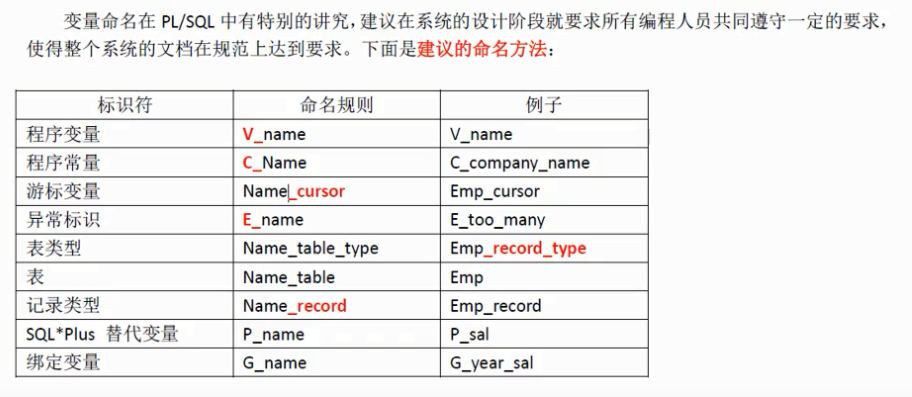
--pl/sql学习
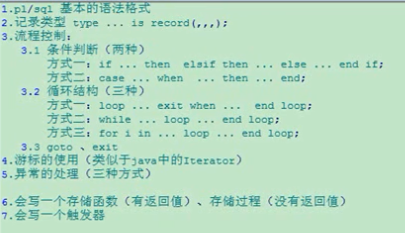
if... then ... elsif... then... else... en if;

loop

循环用while
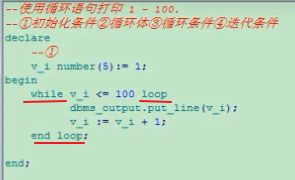
--2~100之间的质数 declare v_i number(3):=2; v_j number(3):=2; v_flag number(1):=1; begin while v_i<=100 loop v_j:=2; while v_j<=sqrt(v_i) loop if v_i mod v_j=0 then v_flag:=0; end if; v_j:=v_j+1; end loop; if v_flag=1 then dbms_output.put_line(v_i); end if; v_i:=v_i+1; v_flag:=1; end loop; end;
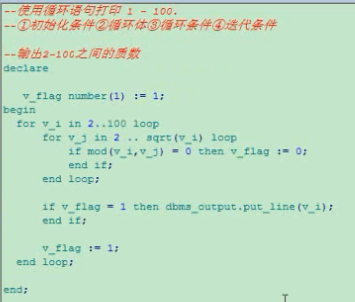
goto
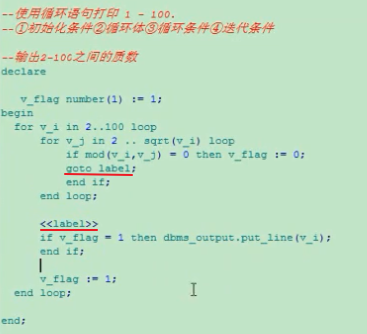


游标
declare --定义变量 v_zzznew_key zzznew.key%type; --定义游标 cursor zzznew_key_coursor is select key from zzznew; begin --打开游标 open zzznew_key_coursor; --提取游标 fetch zzznew_key_coursor into v_zzznew_key;--相当于迭代地的next while zzznew_key_coursor%found loop --found相当于迭代器中hasnext() dbms_output.put_line(v_zzznew_key); fetch zzznew_key_coursor into v_zzznew_key; end loop; --关闭游标 close zzznew_key_coursor; end;


游标推荐使用for循环,因为不需要打开、提取和关闭,在for里会自动的帮我们实现

看来游标使用还是for循环好,非常简洁,但是使用while将更加清晰
--按条件更新c
update zzznew set c=c+(case when c>10 then 1 when c<=10 then -1 else null end)
begin update zzznew set c=c+1 where c>10; update zzznew set c=c-1 where c<=10; end;
begin update zzznew set c=c+(case when c>10 then 1 when c<=10 then -1 else null end); end;
--游标其他的没记录,使用的时候去百度吧
接下来记录存储过程(没有返回值)与存储函数(有返回值)
--存储函数:
create or replace function ceshi(nu number) return varchar2 is v_num number; begin if nu>10 then v_num:=1; else v_num:=0; end if; return to_char(v_num); end;
select ceshi(11) from dual --方法一
begin DBMS_OUTPUT.PUT_LINE(ceshi(11)); --方法二 END;

使用:select get_sal(101) from dual;--获取101部门工资总和
OUT参数

【in】【out】【in out】
in相当于ref(默认)
out相当于out
in out相当于ref与o

例子
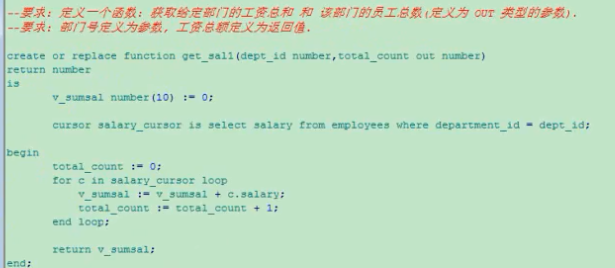

通过以上例子可以看出,out这种一般都是在pl/sql中可以输出,使用基本sql还找不出来